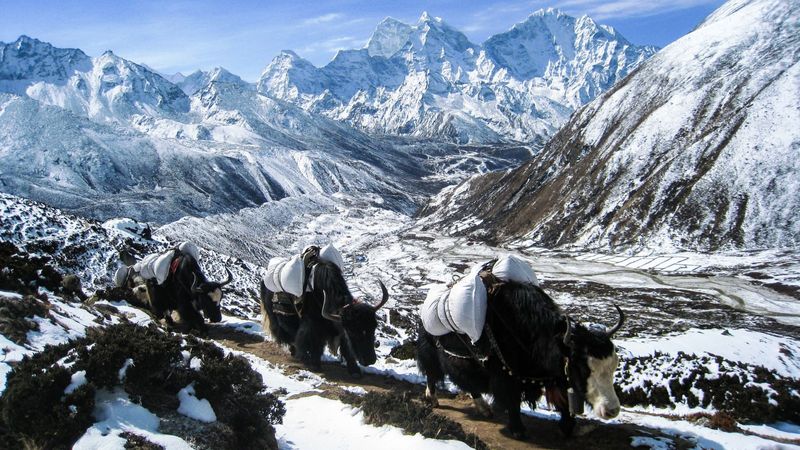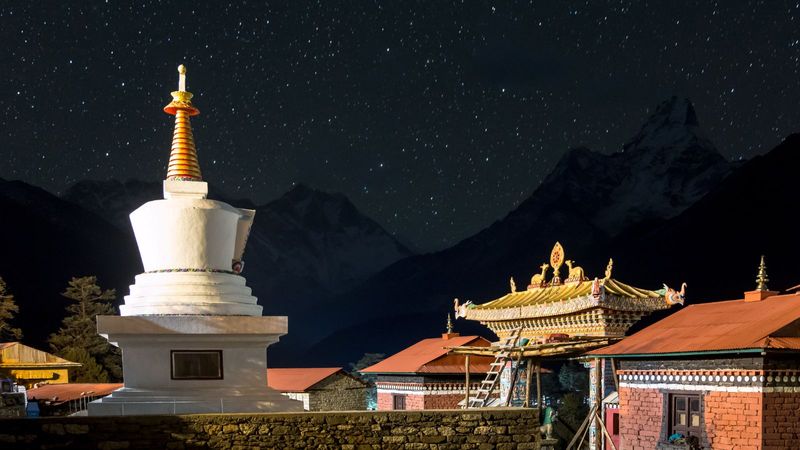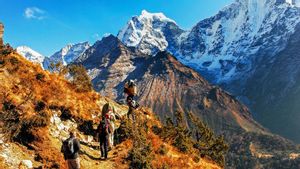Sagarmatha National Park in Nepal is the place of Mount Everest, the highest peak in the world. This park covers an area of 1,148 sq km and was established in 1976. It was also declared a UNESCO Natural World Heritage site in 1979. Furthermore, a buffer zone of 275 sq km was later added in 2002. Gokyo Lake, located inside the park, was also listed as a Ramsar Site in 2007.
The park contains a unique area, boasting the world's highest peak (Mt Everest 8,848.86 m) and the fourth highest peak (Mt. Lhotse 8,516 m). Additionally, there are various peaks above 6000 meters. Apart from these breathtaking mountains, there are many Himalayan glaciers, high-altitude lakes, and deep valleys with rugged terrain. This park is also a part of the Sacred Himalayan Landscape.

The Sherpa influence
Sagarmatha National Park is a popular destination for tourists, but it is also home to the Sherpa people, who are of Tibetan origin and have a culture heavily influenced by Tibet. There are around 20 settlements in the surrounding area, where approximately 6,000 Sherpas live. These villages include Namche Bazar, Kunde, Khumjung, Thyangboche, and Pangboche. During the tourist season, Sherpas from these villages temporarily settle around the trekking trail. In addition to tourism, they also rely on livestock farming and agriculture for their livelihood.
How to reach Sagarmatha National Park in Nepal
Sagarmatha National Park is located about 135 km away from Kathmandu, Nepal. There are multiple ways to reach the park, with the most popular option being to fly to Lukla and hike for two days. Another option is to ride up to Jiri and take a ten-day hike. If you ride up to Salleri, the hike is shortened by five days. Flying to Tumblingtar and Phaplu and hiking for 10 and 5 days respectively is also possible. Additionally, a direct helicopter flight to Namche Bazar, Kala Patthar, or even Everest Base Camp and other destinations inside the park is available.
The most common ways to reach park headquarters, which is situated in Namche, from Kathmandu are:
- Flight to Lukla and two-day trek
- Bus to Jiri and ten-day trek
- Flight to Phaplu and five-day trek
- Drive to Salleri and five-day trek
Best time to visit
The periods are October-November and March-May; December-February is characterized by snow and a daytime temperature of 5 degrees Celsius. June-September is the rainy season.
Entrance fee
The entrance fee for Nepali nationals is NPR 25 per person. SAARC nationals are required to pay NPR 1,500 per person for each entry. Foreigners are required to pay NPR 3,000 per person for each entry.

Wildlife and vegetation
The region boasts a diverse range of wildlife, including Himalayan tahr, goral, musk deer, pika (mouse hare), weasel, jackal, black bear, wolf, lynx and snow leopard. In addition to exploring the natural beauty of the area, those who appreciate birds can observe up to 118 different species, including the Danphe, or impeyan pheasant, the blood pheasant, the red-billed chough, the yellow-billed chough, the snow cock, the snow pigeon, the Himalayan griffon, and many others. The vegetation here is equally breathtaking, with pine and hemlock forests at lower altitudes, and above 3,500 m, forests are dominated by silver fir, birch, rhododendron and juniper trees, creating a serene and peaceful environment for visitors to enjoy.
Let's take a closer look at some of the major animals found in Sagarmatha National Park:

- Snow leopard: The snow leopard is a rare and stunning animal found in Sagarmatha National Park. With its thick, white fur and spotted markings, it's a true marvel of nature. Though a skilled hunter, the snow leopard is an elusive creature and is rarely seen by humans. They can be found at elevations between 3,000 and 5,400 meters, making them well-adapted to the harsh mountain terrain of Sagarmatha National Park.
- Red panda: These adorable creatures are known for their reddish-brown fur and bushy tails. Skilled climbers are often found high up in trees, where they feed on bamboo and other vegetation. Due to their threatened status, red pandas are protected by law in Nepal.
- Himalayan black bear: The Himalayan black bear is a medium-sized bear native to the Himalayas. These bears have a characteristic black coat and a V-shaped mark on their chest. They are omnivorous and feed on a variety of foods, including berries, roots, insects, and small mammals. Typically, Himalayan black bears are found at elevations between 1,800 and 3,600 meters.
- Wild yak: The wild yak is a large, shaggy-haired wild cattle species native to the Himalayan region of Nepal, Tibet, and Bhutan. Their curved horns can grow up to 3 feet in length, and they can weigh up to 1,000 kg, reaching a height of 6 feet at the shoulder. Herbivorous, they feed on grasses and other vegetation found in the high-altitude regions of the park. Unfortunately, due to hunting and habitat loss, the population of wild yaks has been declining, and they are currently classified as vulnerable species by the International Union for Conservation of Nature (IUCN).
- Musk deer: The musk deer is a small, timid deer found in the mountainous regions of Sagarmatha National Park. These deer have a distinctive musk gland, which is used in the perfume industry. They are herbivores and feed on a variety of vegetation, including leaves, shoots, and grasses.

Himalayan Tahr: The Himalayan tahr is a wild goat that lives in the higher elevations of Sagarmatha National Park. With a shaggy coat and curved horns, these goats are skilled climbers and are herbivorous, feeding on a variety of plants, including grasses, leaves, and shrubs.
Tibetan Wolf: The Tibetan wolf is a medium-sized carnivore that is known to prey on small mammals and wild ungulates. Due to its elusive nature, it's a rare sight in the park.

Things to do at Sagarmatha National Park in Nepal
Trekking
Trekking on the Everest Base Camp route is the main activity in Sagarmatha National Park. The route offers breathtaking views of Mt. Everest as well as other renowned peaks like Cho Oyu, Pumori, Thamserku, and Ama Dablam. Mountaineering is also a major activity in the region, with hundreds of climbers visiting the park every year to summit Mt. Everest and other peaks. Additionally, a Helicopter tour to Everest Base Camp is a popular attraction for tourists and mountain enthusiasts alike.

Visiting monasteries
As a result of the Tibetan influence and the practice of Buddhism in the region, numerous monasteries are worth visiting. Some of the famous monasteries in the area include Tengboche, Thame, Khumjung, and Pangboche. These monasteries are also popular gathering places during festivals such as Dumje and Mane Rumdu.

Exploring Gokyo Lakes and Dudh Koshi River
The Gokyo Lakes are a beautiful high-altitude lake complex located in Sagarmatha National Park. There are six lakes in the complex, and the largest of them is called Lake Thonak. Camping around the lakes or spending a day in the park can be an enthralling experience, thanks to the spectacular views of the surrounding mountains and glaciers, including the mighty Everest. So, if you visit this place, you can enjoy the serene and natural beauty of Gokyo Lakes while also experiencing the thrill of adventure.
Dudh Koshi River in the south offers spectacular views of streaming water over rough landscapes. One of the top things to do in Sagarmatha National Park is to spend time on the banks of this powerful river and enjoy the stunning natural beauty it offers. The river has several suspension bridges that provide even more breathtaking views.


_1711810524033_thumb_1200.jpeg?w=3840&q=75)

